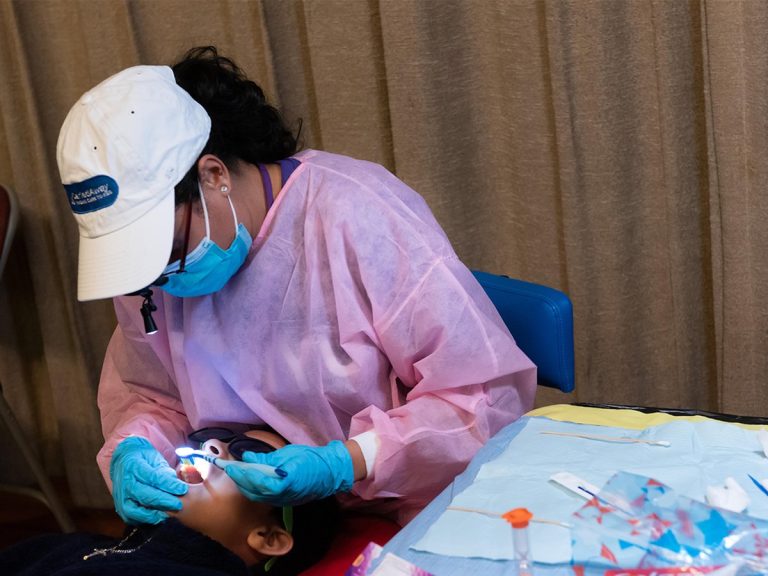WEDNESDAY, Feb. 22, 2023 (HealthDay News) — Children can be spared cavities and potentially painful dental work with a simple brushing treatment, according to a new clinical trial.
The study tested the effects of a topical treatment, called silver diamine fluoride (SDF), in 47 New York City elementary schools. The researchers found that an application of SDF was as effective as standard dental treatments in preventing tooth decay and keeping existing cavities from worsening for two years.
SDF is a clear liquid that combines the antibacterial properties of silver with the ability of fluoride to “remineralize” and strengthen the surface of the teeth.
Since SDF is easy to use and relatively inexpensive — and could be provided by nurses rather than dentists — experts said it’s ideal for school dental programs.
“To be able to see such an impact is wonderful,” he said Ryan Richard Ruffco-principal investigator on the trial and associate professor at NYU College of Dentistry in New York.
The trial, which began in 2019, was suspended due to the pandemic. Thus, the nearly 3,000 participating children could receive only one dental treatment, instead of the planned frequency of twice a year.
Still, SDF prevented tooth decay for two years in more than 80% of the children who received it—just as well as their peers who received standard treatment, including dental sealants. And for children with existing cavities, both SDF and standard care prevented about half from worsening.
The findings were published online earlier this month JAMA Network Open.
In the United States, conventional dental care is expensive and many Americans cannot afford it. An estimated 77 million U.S. adults lack dental insurance, according to a 2022 survey by the nonprofit CareQuest Institute for Oral Health.
And as in other areas of health care, there are disparities: Blacks and Hispanics and low-income Americans have a particularly hard time getting dental care and are more likely to have tooth decay and gingivitis.
So schools are seen as a place to fill the gap, bringing dental care to kids where they already are, Ruff said.
But it also highlights the need for alternatives to the traditional “drill and fill” variety of cavity care.
“It’s time to move forward and use materials that are simpler and cheaper,” he said Dr. Peter Milgromprofessor emeritus of oral health sciences at the University of Washington in Seattle.
Milgrom, who was not involved in the trial, introduced SDF to the United States when he began using it in his own practice in the 1990s. SDF was first developed in Japan decades ago, and Milgrom learned about the treatment after researchers in Hong Kong they put it to the first rigorous test in a clinical trial.
But it wasn’t until 2014 that the US Food and Drug Administration cleared SDF as a tooth desensitizing agent. In the real world, it is also used off-label to stop early cavities in their tracks.
At this point, Milgrom said, SDF has been widely adopted by pediatric dentists in the United States — but awareness is still lacking among general dentists.
The new test, Milgrom said, “absolutely” supports the broader use of SDF in school programs.
For the study, Ruff’s team randomly assigned 47 elementary schools to one of two groups: In one, children in kindergarten through third grade received “simple” dental care that included SDF application plus fluoride varnish.
Children in the comparison group were given fluoride varnish plus a standard dental glassyomer sealant — a paste containing powdered glass that is painted on the back teeth as a protective coating. When necessary, they had also scraped away the existing caries with hand instruments.
In the end, Ruff’s team found that both approaches worked equally well.
The findings are “really exciting,” according to Dr Jeremy Horst Kipper.
He is a pediatric dentist and director of clinical innovation for CareQuest Innovation Partners, in Boston — the for-profit subsidiary of the nonprofit CareQuest Institute.
The trial shows that even a one-time, “easy and painless” SDF treatment can arrest half the cavities over two years — during a pandemic, when Americans’ diets often took a turn for the worse, Horst Keeper pointed out.
The fact that SDF was as effective as standard care, he said, is “amazing.”
This is not to say that the SDF is without its drawbacks. When applied to cavities, it leaves behind a dark stain. For this reason, Ruff said, the children in the trial received SDF only up to their back teeth.
“That’s where wear and tear happens most often anyway,” he noted.
Ideally, all three experts said, every child should have access to care from a dentist. But that’s not the reality for many children in the US, as well as adults.
Therefore, it is important to have treatments that allow dental care to be provided by other health professionals and in non-traditional settings such as schools and nursing homes.
“Overall, what we’re seeing now is that minimally invasive treatments in dentistry are working,” said Horst Keeper. “And people should have access to them, wherever they are.”
The research was funded by the nonprofit Patient-Centered Outcomes Research Institute.
More information
The American Dental Association has more silver fluoride diamine.
SOURCES: Ryan Richard Ruff, PhD, MPH, associate professor, department of epidemiology and health promotion, NYU College of Dentistry, New York. Jeremy Horst Keeper, DDS, PhD, director of clinical innovation, CareQuest Innovation Partners, Boston. Peter Milgrom, DDS, professor emeritus, oral health sciences, University of Washington, Seattle. JAMA Network Open9 Feb 2023, online

